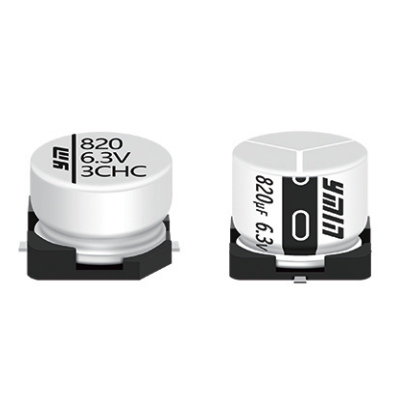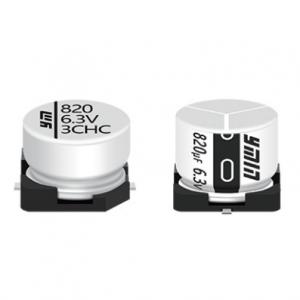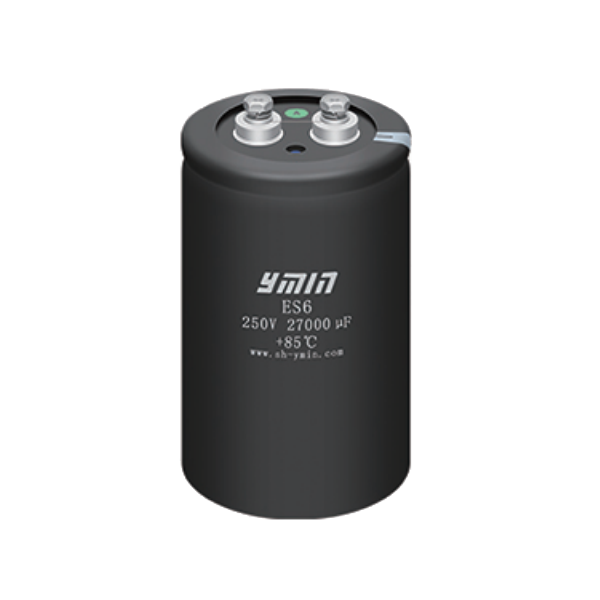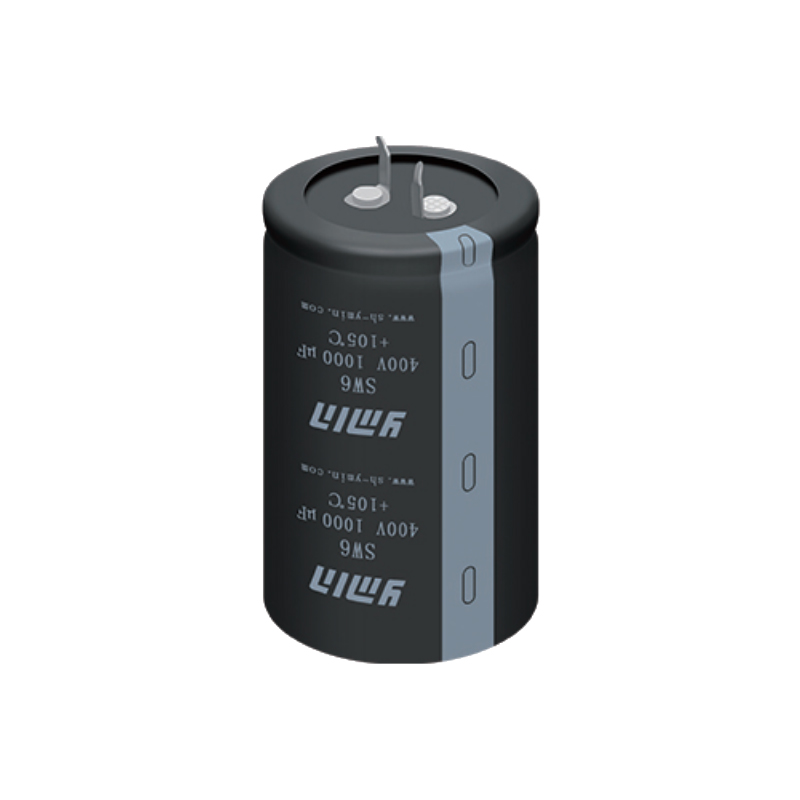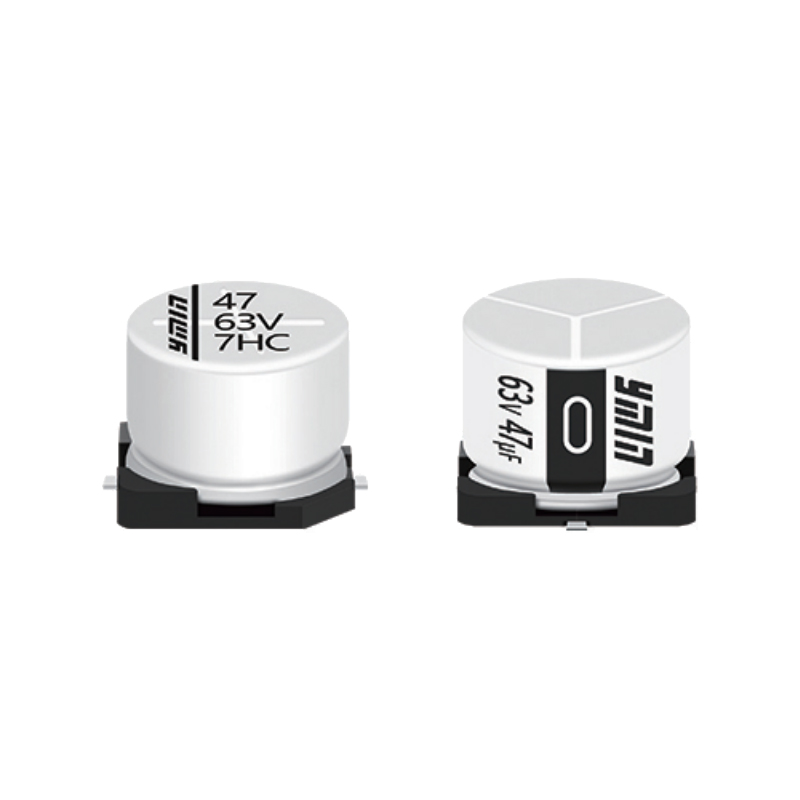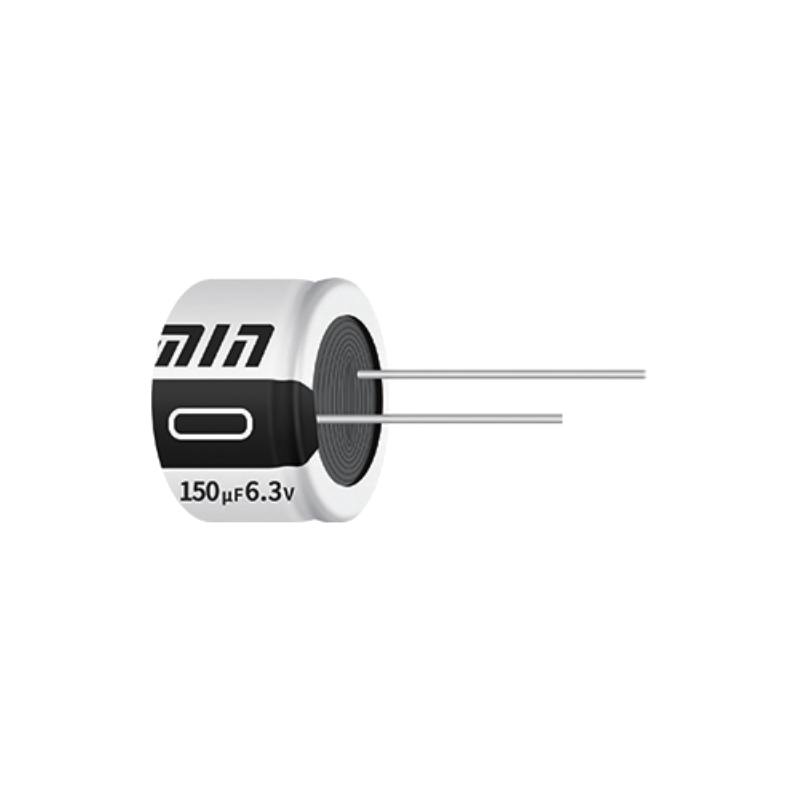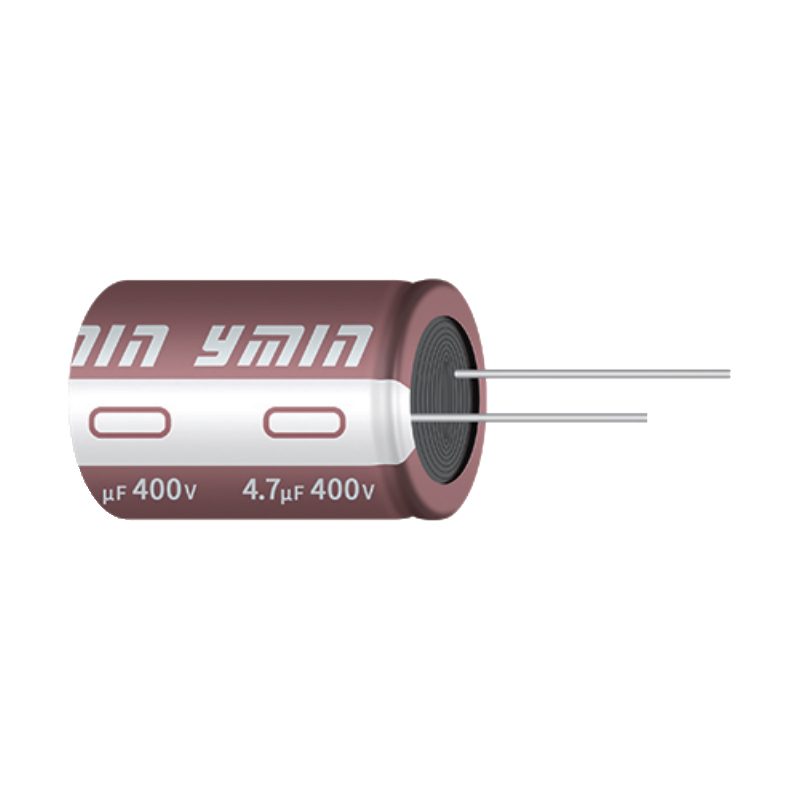Main technical parameters
Technical Parameter
♦Ultra-high capacity, low impedance and miniaturized V-CHIP products are guaranteed for 2000 hours
♦Suitable for high-density automatic surface mount high temperature reflow soldering
♦Conforming to AEC-Q200 RoHS Directive, please contact us for details
The main technical parameters
|
Project |
characteristic |
|||||||||||
|
Operating temperature range |
-55~+105℃ |
|||||||||||
|
Nominal voltage range |
6.3-35V |
|||||||||||
|
Capacity tolerance |
220~2700uF |
|||||||||||
|
Leakage current (uA) |
±20% (120Hz 25℃) |
|||||||||||
|
I≤0.01 CV or 3uA whichever is larger C: Nominal capacity uF) V: Rated voltage (V) 2 minutes reading |
||||||||||||
|
Loss Tangent (25±2℃ 120Hz) |
Rated Voltage(V) |
6.3 |
10 |
16 |
25 |
35 |
|
|
|
|||
|
tg 6 |
0.26 |
0.19 |
0.16 |
0.14 |
0.12 |
|
|
|
||||
|
If the nominal capacity exceeds 1000uF, the loss tangent value will increase by 0.02 for each increase of 1000uF |
||||||||||||
|
Temperature Characteristics (120Hz) |
Rated voltage (V) |
6.3 |
10 |
16 |
25 |
35 |
||||||
|
Impedance ratio MAX Z(-40℃)/Z(20℃) |
3 |
3 |
3 |
3 |
3 |
|||||||
|
Durability |
In an oven at 105°C, apply the rated voltage for 2000 hours, and test it at room temperature for 16 hours. The test temperature is 20°C. The performance of the capacitor should meet the following requirements |
|||||||||||
|
Capacity change rate |
Within ±30% of initial value |
|||||||||||
|
loss tangent |
Below 300% of the specified value |
|||||||||||
|
leakage current |
Below the specified value |
|||||||||||
|
high temperature storage |
Store at 105°C for 1000 hours, test after 16 hours at room temperature, the test temperature is 25±2°C, the performance of the capacitor should meet the following requirements |
|||||||||||
|
Capacity change rate |
Within ±20% of initial value |
|||||||||||
|
loss tangent |
Below 200% of the specified value |
|||||||||||
|
leakage current |
Below 200% of the specified value |
|||||||||||
Product Dimensional Drawing
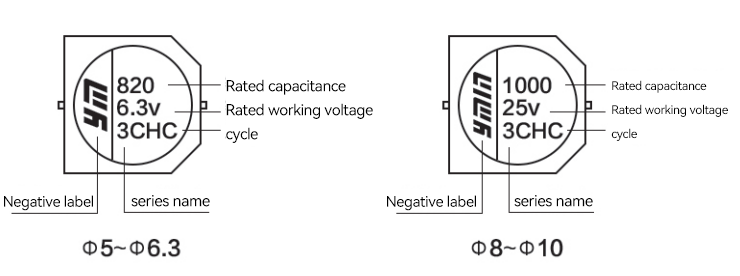
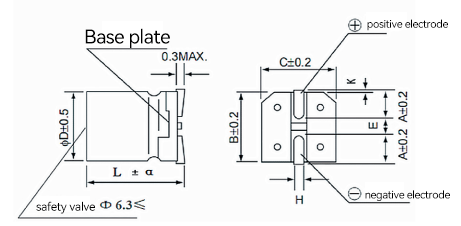
Dimension(unit:mm)
|
ΦDxL |
A |
B |
C |
E |
H |
K |
a |
|
6.3x77 |
2.6 |
6.6 |
6.6 |
1.8 |
0.75±0.10 |
0.7MAX |
±0.4 |
|
8x10 |
3.4 |
8.3 |
8.3 |
3.1 |
0.90±0.20 |
0.7MAX |
±0.5 |
|
10x10 |
3.5 |
10.3 |
10.3 |
4.4 |
0.90±0.20 |
0.7MAX |
±0.7 |
Ripple current frequency correction coefficient
|
Frequency (Hz) |
50 |
120 |
1K |
310K |
|
coefficient |
0.35 |
0.5 |
0.83 |
1 |
YMIN Electronics V3MC Series: Ultra-High Capacitance Surface Mount Aluminum Electrolytic Capacitors, Powering High-Density Electronic Designs
In today's world of increasingly miniaturized and efficient electronic devices, every millimeter of space on a circuit board is precious. Engineers often face a core challenge: how to achieve higher energy storage and more efficient power filtering within extremely limited space? YMIN Electronics deeply understands this design challenge and, leveraging its extensive experience in aluminum electrolytic capacitor R&D and manufacturing, has launched the V3MC series of surface mount aluminum electrolytic capacitors. This product is not only a model of the "small size, large capacity" design concept but also a reliable energy solution for high-end applications such as automotive electronics, AI servers, and industrial drives.
I. Core Product Positioning: Defining a New Standard for Miniaturized High-Capacitance Capacitors
The core value of the V3MC series lies in its revolutionary "ultra-high capacitance" and "low equivalent series resistance (ESR)" characteristics. Compared to conventional products of the same size, the V3MC offers a wide capacitance range from 220μF to 2700μF and a voltage range from 6.3V to 35V within the same standard SMD package (such as the classic 6.3x7.7mm, 8x10mm, and 10x10mm). This means that at critical points such as power filtering and energy buffering, a single V3MC capacitor can provide significantly more energy storage and ripple absorption than ordinary products, effectively addressing the stringent power stability requirements of high-power chips (such as CPUs, GPUs, and ASICs) under sudden load changes.
This product series is designed specifically for ultra-high-density PCB environments and is fully compatible with fully automated surface mount technology and high-temperature reflow soldering processes. Its robust structure ensures that it is not easily damaged during soldering, greatly improving mass production yield and meeting the demands of consumer electronics, communication equipment, and other fields for high-efficiency, low-cost manufacturing.
II. In-depth Technical Analysis: Superior Performance Stems from Meticulous Attention to Detail
1. Ultra-Low ESR and High Ripple Current Capability:
The low ESR characteristic of the V3MC series is one of its biggest highlights. Data shows that its ESR value can be as low as 0.09Ω (e.g., V3MCE1000J272MV model). Low ESR directly brings two major advantages: firstly, it reduces the energy loss (heat generation) of the capacitor itself under high-frequency operation, improving energy efficiency; secondly, it significantly enhances the ability to withstand ripple current.
For example, the 10x10mm package model can withstand ripple currents up to 1200mA, which is crucial for the output filtering circuit of switching power supplies, ensuring that the system maintains voltage purity and stability even under full load.
2. Long Durability and High-Temperature Stability:
The V3MC series promises a load life of at least 2000 hours under rated voltage at a high temperature of 105℃. This rigorous durability test simulates the long-term performance of the capacitor under harsh operating conditions. Capacitors that pass testing signify longer lifespan and higher reliability in real-world applications. Whether it's a control unit exposed to extreme temperatures in a car's engine compartment or a server power supply densely deployed in a data center operating at consistently high temperatures, V3MC provides sustained performance assurance.
3. Stringent Quality and Compliance Certifications:
The Yung Ming V3MC series complies with the RoHS environmental directive, and many models have passed the AEC-Q200 automotive-grade reliability certification. AEC-Q200 is not simply a quality compliance mark, but a series of extremely stringent stress tests, including high-temperature load life, temperature cycling, and moisture resistance. Passing this certification signifies that V3MC's quality is sufficient to meet the zero-tolerance requirements for safety and reliability in the automotive electronics field, providing authoritative endorsement for the product's entry into the supply chain of new energy vehicles (OBC, DC-DC converters), ADAS systems, and other applications.
III. Application Scenarios Overview: In which fields does V3MC shine?
1. Automotive Electronics: The "Anchor of Stability" for Intelligent Driving
With the increasing electrification and intelligence of automobiles, the demand for capacitors in automotive electronic systems is growing exponentially. In on-board chargers (OBCs), V3MC's high capacity and low ESR effectively smooth the high-voltage DC power after rectification; in DC-DC converters, it provides efficient energy buffering for 12V/48V circuits; in sensor modules and computing platforms of Advanced Driver Assistance Systems (ADAS), V3MC ensures stable power supply to core chips during periods of severe current fluctuation, safeguarding driving safety. Its automotive-grade certification allows designers to use it with confidence.
2. Data Centers and Communication Equipment: The "Energy Foundation" of the Computing Power Era
AI data servers, 5G base stations, and other equipment have extremely high requirements for power density and efficiency. V3MC is ideally suited for applications such as server power supplies (PSUs) and base station power amplifiers. Its ultra-high capacity effectively handles the transient high current demands of computing units such as CPUs/FPGAs, preventing voltage sags. Simultaneously, its low ESR characteristics help reduce overall power system losses, contributing to lower PUE (Power Usage Effectiveness) and achieving green data center goals.
3. Industrial Automation and Drives: The Unsung Hero of Powerful Performance
In inverters, servo drives, industrial robots, and other equipment, V3MC is commonly used in the buffer circuits of inverters (IGBT/MOSFET) and DC-Link support. Its fast charging and discharging capabilities and high ripple current tolerance can absorb voltage spikes generated during switching, protecting power devices while improving the accuracy and efficiency of motor control. In power modules for smart meters and smart homes, its miniaturization helps achieve compact and aesthetically pleasing product designs.
4. Consumer Electronics and Fast Charging Technology: A Compact "Energy Monster"
In consumer electronics products such as gallium nitride (GaN) PD fast chargers, LED TV driver boards, and game consoles, PCB space is extremely limited. With its advantages of "small size and large capacity," the V3MC can provide sufficient filtering capacitance within a limited space, ensuring the quality of the output power supply while meeting the trend of thinner and lighter product designs.
IV. Added Value of Choosing V3MC: A Partner Beyond the Component Itself
Choosing the YMIN V3MC series means you get more than just a high-performance capacitor:
• Facilitate Product Innovation: Enables more powerful functionality in a smaller space, providing hardware support for product differentiation.
• Enhance System Reliability: Reduces system failures caused by capacitor failure at the source, improving the brand reputation and user satisfaction of end products.
• Simplify Supply Chain Management: YMIN offers a complete selection of models covering mainstream capacitance and voltage, with most models having automotive-grade options, supporting one-stop purchasing and reducing supplier management costs.
• Gain Expert Support: YMIN has over twenty years of experience in the R&D and manufacturing of aluminum electrolytic capacitors. Its technical team can provide customers with full-chain technical support from selection and testing to application, becoming an extension of your product development.
Conclusion
In the rapidly evolving landscape of electronic technology, Yung Ming Electronics' V3MC series ultra-high capacitance surface-mount aluminum electrolytic capacitors, with their superior performance, robust reliability, and wide application adaptability, have become a powerful tool for engineers to address the challenges of high-density, high-performance designs. Silently integrated into the core circuits of various high-end electronic devices, they act like efficient and reliable "energy sponges," constantly absorbing fluctuations and stabilizing voltage, laying a solid foundation for the stable and efficient operation of the system. Choosing V3MC means choosing a product driven by technological innovation and a guarantee of success.
| Products Number | Operating temperature (℃) | Voltage(V.DC) | Capacitance(uF) | Diameter(mm) | Length(mm) | Leakage current (uA) | Rated ripple current [mA/r.m.s] | ESR/ Impedance [Ωmax] | Life (hrs) | Certification |
| V3MCC0770J821MV | -55~105 | 6.3 | 820 | 6.3 | 7.7 | 51.66 | 610 | 0.24 | 2000 | - |
| V3MCC0770J821MVTM | -55~105 | 6.3 | 820 | 6.3 | 7.7 | 51.66 | 610 | 0.24 | 2000 | AEC-Q200 |
| V3MCD1000J182MV | -55~105 | 6.3 | 1800 | 8 | 10 | 113.4 | 860 | 0.12 | 2000 | - |
| V3MCD1000J182MVTM | -55~105 | 6.3 | 1800 | 8 | 10 | 113.4 | 860 | 0.12 | 2000 | AEC-Q200 |
| V3MCE1000J272MV | -55~105 | 6.3 | 2700 | 10 | 10 | 170.1 | 1200 | 0.09 | 2000 | - |
| V3MCE1000J272MVTM | -55~105 | 6.3 | 2700 | 10 | 10 | 170.1 | 1200 | 0.09 | 2000 | AEC-Q200 |
| V3MCC0771A561MV | -55~105 | 10 | 560 | 6.3 | 7.7 | 56 | 610 | 0.24 | 2000 | - |
| V3MCC0771A561MVTM | -55~105 | 10 | 560 | 6.3 | 7.7 | 56 | 610 | 0.24 | 2000 | AEC-Q200 |
| V3MCD1001A122MV | -55~105 | 10 | 1200 | 8 | 10 | 120 | 860 | 0.12 | 2000 | - |
| V3MCD1001A122MVTM | -55~105 | 10 | 1200 | 8 | 10 | 120 | 860 | 0.12 | 2000 | AEC-Q200 |
| V3MCE1001A222MV | -55~105 | 10 | 2200 | 10 | 10 | 220 | 1200 | 0.09 | 2000 | - |
| V3MCE1001A222MVTM | -55~105 | 10 | 2200 | 10 | 10 | 220 | 1200 | 0.09 | 2000 | AEC-Q200 |
| V3MCC0771C471MV | -55~105 | 16 | 470 | 6.3 | 7.7 | 75.2 | 610 | 0.24 | 2000 | - |
| V3MCC0771C471MVTM | -55~105 | 16 | 470 | 6.3 | 7.7 | 75.2 | 610 | 0.24 | 2000 | AEC-Q200 |
| V3MCD1001C821MV | -55~105 | 16 | 820 | 8 | 10 | 131.2 | 860 | 0.12 | 2000 | - |
| V3MCD1001C821MVTM | -55~105 | 16 | 820 | 8 | 10 | 131.2 | 860 | 0.12 | 2000 | AEC-Q200 |
| V3MCE1001C152MV | -55~105 | 16 | 1500 | 10 | 10 | 240 | 1200 | 0.09 | 2000 | - |
| V3MCE1001C152MVTM | -55~105 | 16 | 1500 | 10 | 10 | 240 | 1200 | 0.09 | 2000 | AEC-Q200 |
| V3MCC0771E331MV | -55~105 | 25 | 330 | 6.3 | 7.7 | 82.5 | 610 | 0.24 | 2000 | - |
| V3MCC0771E331MVTM | -55~105 | 25 | 330 | 6.3 | 7.7 | 82.5 | 610 | 0.24 | 2000 | AEC-Q200 |
| V3MCD1001E561MV | -55~105 | 25 | 560 | 8 | 10 | 140 | 860 | 0.12 | 2000 | - |
| V3MCD1001E561MVTM | -55~105 | 25 | 560 | 8 | 10 | 140 | 860 | 0.12 | 2000 | AEC-Q200 |
| V3MCE1001E102MV | -55~105 | 25 | 1000 | 10 | 10 | 250 | 1200 | 0.09 | 2000 | - |
| V3MCE1001E102MVTM | -55~105 | 25 | 1000 | 10 | 10 | 250 | 1200 | 0.09 | 2000 | AEC-Q200 |
| V3MCC0771V221MV | -55~105 | 35 | 220 | 6.3 | 7.7 | 77 | 610 | 0.24 | 2000 | - |
| V3MCC0771V221MVTM | -55~105 | 35 | 220 | 6.3 | 7.7 | 77 | 610 | 0.24 | 2000 | AEC-Q200 |
| V3MCD1001V471MV | -55~105 | 35 | 470 | 8 | 10 | 164.5 | 860 | 0.12 | 2000 | - |
| V3MCD1001V471MVTM | -55~105 | 35 | 470 | 8 | 10 | 164.5 | 860 | 0.12 | 2000 | AEC-Q200 |
| V3MCE1001V681MV | -55~105 | 35 | 680 | 10 | 10 | 238 | 1200 | 0.09 | 2000 | - |
| V3MCE1001V681MVTM | -55~105 | 35 | 680 | 10 | 10 | 238 | 1200 | 0.09 | 2000 | AEC-Q200 |
